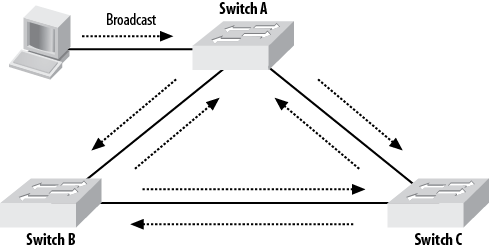Chapter 8. Spanning Tree
The Spanning Tree Protocol (STP) is used to ensure that no Layer-2 loops exist in a LAN. As youâll see in this chapter, Layer-2 loops can cause havoc.
Note
Spanning tree is designed to prevent loops among bridges. A bridge is a device that connects multiple segments within a single collision domain. Switches are considered bridgesâhubs are not. While the spanning tree documentation always refers to bridges generically, my examples will show switches. Switches are generally the devices in which you will encounter spanning tree.
When a switch receives a broadcast, it repeats the broadcast on every port (except the one on which it was received). In a looped environment, the broadcasts are repeated forever. The result is called a broadcast storm, and it will quickly bring a network to a halt.
Figure 8-1 illustrates what can happen when thereâs a loop in a network.

Figure 8-1. Broadcast storm
The computer on Switch A sends out a broadcast frame. Switch A then sends a copy of the broadcast to Switch B and Switch C. Switch B repeats the broadcast to Switch C, and Switch C repeats the broadcast to Switch B; Switch B and Switch C also repeat the broadcast back to Switch A. Switch A then repeats the broadcast it heard from Switch B to Switch C and the broadcast it heard from Switch C to Switch B. This progression will continue indefinitely until the loop is somehow ...
Get Network Warrior, 2nd Edition now with the O’Reilly learning platform.
O’Reilly members experience books, live events, courses curated by job role, and more from O’Reilly and nearly 200 top publishers.

